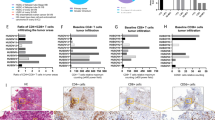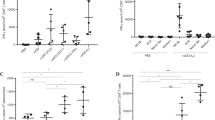Abstract
Human peripheral blood lymphocytes (PBLs) electroporated with RNA encoding anti-Her-2/neu-specific chimeric immune receptor (CIR) have been reported to elicit potent immune responses against SKOV3 tumors in a nude mouse model. However, CIR-electroporated PBL (CIR-PBL) did not proliferate, and the cell number rapidly decreased in the absence of exogenous interleukin-2 (IL-2). In this study, PBLs electroporated with both CIR and IL-2 RNA (CIR/IL-2-PBL) were studied to determine whether antitumor effects could be improved by adoptive immunotherapy. CIR and IL-2 were expressed in CIR/IL-2-PBL at levels similar to PBLs electroporated, with IL-2 RNA (IL-2-PBL) or CIR-PBL. Transfer of IL-2 RNA induced proliferation and prolonged survival of PBLs in vitro. In a xenograft model, both IL-2-PBL and CIR/IL-2-PBL showed significantly higher antitumor effects than CIR-PBL. The number of tumor-infiltrating natural killer (NK) cells was significantly increased in IL-2-PBL and CIR/IL-2-PBL. After NK cell depletion, IL-2-PBL showed significantly lower antitumor effects than CIR/IL-2-PBL. These results suggest that transfer of IL-2 RNA to CIR-PBL can promote NK cell infiltration of tumors and prolong survival of infused PBLs in vivo. RNA electroporated PBLs may represent efficient tools for delivery of functional molecules to tumors by multiple gene transfer.
This is a preview of subscription content, access via your institution
Access options
Subscribe to this journal
Receive 12 print issues and online access
$259.00 per year
only $21.58 per issue
Buy this article
- Purchase on Springer Link
- Instant access to full article PDF
Prices may be subject to local taxes which are calculated during checkout






Similar content being viewed by others
References
June CH . Adoptive T cell therapy for cancer in the clinic. J Clin Invest 2007; 117: 1466–1476.
Yee C, Thompson JA, Byrd D, Riddell SR, Roche P, Celis E et al. Adoptive T cell therapy using antigen-specific CD8+ T cell clones for the treatment of patients with metastatic melanoma: in vivo persistence, migration, and antitumor effect of transferred T cells. Proc Natl Acad Sci USA 2002; 25: 15840–15842.
Cho HI, Hong YS, Lee MA, Kim EK, Yoon SH, Kim CC et al. Adoptive transfer of Epstein–Barr virus-specific cytotoxic T-lymphocytes for the treatment of angiocentric lymphomas. Int J Hematol 2006; 83: 66–73.
Roskrow MA, Suzuki N, Gan Y, Sixbey JW, Ng CY, Kimbrough S et al. Epstein–Barr virus (EBV)-specific cytotoxic T lymphocytes for the treatment of patients with EBV-positive relapsed Hodgkin's disease. Blood 1998; 91: 2925–2934.
Stephan MT, Ponomarev V, Brentjens RJ, Chang AH, Dobrenkov KV, Heller G et al. T cell-encoded CD80 and 4-1BBL induce auto- and transcostimulation, resulting in potent tumor rejection. Nat Med 2007; 13: 1440–1449.
Xue S, Gillmore R, Downs A, Tsallios A, Holler A, Gao L et al. Exploiting T cell receptor genes for cancer immunotherapy. Clin Exp Immunol 2005; 139: 167–172.
Gattinoni L, Powell Jr DJ, Rosenberg SA, Restifo NP . Adoptive immunotherapy for cancer: building on success. Nat Rev Immunol 2006; 6: 383–393.
Birkholz K, Hombach A, Krug C, Reuter S, Kershaw M, Kämpgen E et al. Transfer of mRNA encoding recombinant immunoreceptors reprograms CD4+ and CD8+ T cells for use in the adoptive immunotherapy of cancer. Gene Therapy 2009; 16: 596–604.
Yoon SH, Lee JM, Cho HI, Kim EK, Kim HS, Park MY et al. Adoptive immunotherapy using human peripheral blood lymphocytes transferred with RNA encoding Her-2/neu-specific chimeric immune receptor in ovarian cancer xenograft model. Cancer Gene Ther 2009; 16: 489–497.
Eshhar Z, Waks T, Bendavid A, Schindler DG . Functional expression of chimeric receptor genes in human T cells. J Immunol Methods 2001; 248: 67–76.
Haynes NM, Trapani JA, Teng MW, Jackson JT, Cerruti L, Jane SM et al. Rejection of syngeneic colon carcinoma by CTLs expressing single-chain antibody receptors codelivering CD28 costimulation. J Immunol 2002; 169: 5780–5786.
Paulos CM, Wrzesinski C, Kaiser A, Hinrichs CS, Chieppa M, Cassard L et al. Microbial translocation augments the function of adoptively transferred self/tumor-specific CD8+ T cells via TLR4 signaling. J Clin Invest 2007; 117: 2197–2204.
Ambade A, Mulherkar R . Adoptive T cell transfer augments IL-2 mediated tumour regression in a HNSCC xenograft nude mouse model. Cancer Lett 2008; 272: 316–324.
Smith KA . Interleukin-2: inception, impact, and implications. Science 1988; 240: 1169–1176.
Dunne J, Lynch S, O'Farrelly C, Todryk S, Hegarty JE, Feighery C et al. Selective expansion and partial activation of human NK cells and NK receptor-positive T cells by IL-2 and IL-15. J Immunol 2001; 167: 3129–3138.
Klingemann HG, Martinson J . Ex vivo expansion of natural killer cells for clinical applications. Cytotherapy 2004; 6: 15–22.
Den Otter W, Jacobs JJ, Battermann JJ, Hordijk GJ, Krastev Z, Moiseeva EV et al. Local therapy of cancer with free IL-2. Cancer Immunol Immunother 2008; 57: 931–950.
Schadendorf D, Algarra SM, Bastholt L, Cinat G, Dreno B, Eggermont AM et al. Immunotherapy of distant metastatic disease. Ann Oncol 2009; 20: 41–50.
Tsao H, Atkins MB, Sober AJ . Management of cutaneous melanoma. N Engl J Med 2004; 351: 2770–2771.
Heemskerk B, Liu K, Dudley ME, Johnson LA, Kaiser A, Downey S et al. Adoptive cell therapy for patients with melanoma, using tumor-infiltrating lymphocytes genetically engineered to secrete interleukin-2. Hum Gene Ther 2008; 19: 496–510.
Jacobs JJ, Hordijk GJ, Jürgenliemk-Schulz IM, Terhaard CH, Koten JW, Battermann JJ et al. Treatment of stage III-IV nasopharyngeal carcinomas by external beam irradiation and local low doses of IL-2. Cancer Immunol Immunother 2005; 54: 792–798.
Maas RA, Van Weering DH, Dullens HF, Den Otter W . Intratumoral low-dose interleukin-2 induces rejection of distant solid tumour. Cancer Immunol Immunother 1991; 33: 389–394.
Yoon SH, Lee JM, Woo SJ, Park MJ, Park JS, Kim HS et al. Transfer of Her-2/neu specificity into cytokine-induced killer (CIK) cells with RNA encoding chimeric immune receptor (CIR). J Clin Immunol 29: 806–814.
Baum C, Kustikova O, Modlich U, Li Z, Fehse B . Mutagenesis and oncogenesis by chromosomal insertion of gene transfer vectors. Hum Gene Ther 2006; 17: 253–263.
Gaffen SL, Liu KD . Overview of interleukin-2 function, production and clinical applications. Cytokine 2004; 28: 109–123.
Slos P, De Meyer M, Leroy P, Rousseau C, Acres B . Immunotherapy of established tumors in mice by intratumoral injection of an adenovirus vector harboring the human IL-2 cDNA: induction of CD8+ T-cell immunity and NK activity. Cancer Gene Ther 2001; 8: 321–332.
Fearon ER, Pardoll DM, Itaya T, Golumbek P, Levitsky HI, Simons JW et al. Interleukin-2 production by tumor cells bypasses T helper function in the generation of an antitumor response. Cell 1990; 60: 397–403.
Kim EJ, Cho D, Hwang SY, Kim TS . Interleukin-2 fusion protein with anti-CD3 single-chain Fv (sFv) selectively protects T cells from dexamethasone-induced apoptosis. Vaccine 2001; 20: 608–615.
Liu K, Rosenberg SA . Transduction of an IL-2 gene into human melanoma-reactive lymphocytes results in their continued growth in the absence of exogenous IL-2 and maintenance of specific antitumor activity. J Immunol 2001; 167: 6356–6365.
Marks-Konczalik J, Dubois S, Losi JM, Sabzevari H, Yamada N, Feigenbaum L et al. IL-2-induced activation-induced cell death is inhibited in IL-15 transgenic mice. Proc Natl Acad Sci USA 2000; 97: 11445–11450.
Waldmann TA . The biology of interleukin-2 and interleukin-15: implications for cancer therapy and vaccine design. Nat Rev Immunol 2006; 6: 595–601.
Zambricki E, Shigeoka A, Kishimoto H, Sprent J, Burakoff S, Carpenter C et al. Signaling T-cell survival and death by IL-2 and IL-15. Am J Transplant 2005; 5: 2623–2631.
Hsu C, Hughes MS, Zheng Z, Bray RB, Rosenberg SA, Morgan RA . Primary human T lymphocytes engineered with a codon-optimized IL-15 gene resist cytokine withdrawal-induced apoptosis and persist long-term in the absence of exogenous cytokine. J Immunol 2005; 175: 7226–7234.
Rufer N, Migliaccio M, Antonchuk J, Humphries RK, Roosnek E, Lansdorp PM . Transfer of the human telomerase reverse transcriptase (TERT) gene into T lymphocytes results in extension of replicative potential. Blood 2001; 98: 597–603.
Teng MW, Kershaw MH, Moeller M, Smyth MJ, Darcy PK . Immunotherapy of cancer using systemically delivered gene-modified human T lymphocytes. Hum Gene Ther 2004; 15: 699–708.
Moeller M, Haynes NM, Kershaw MH, Jackson JT, Teng MW, Street SE et al. Adoptive transfer of gene-engineered CD4+ helper T cells induces potent primary and secondary tumor rejection. Blood 2005; 106: 2995–3003.
Ferber D . Gene therapy: safer and virus-free? Science 2001; 294: 1638–1642.
Hacein-Bey-Abina S, Von Kalle C, Schmidt M, McCormack MP, Wulffraat N, Leboulch P et al. LMO2-associated clonal T cell proliferation in two patients after gene therapy for SCID-X1. Science 2003; 302: 415–419.
Nienhuis AW, Dunbar CE, Sorrentino BP . Genotoxicity of retroviral integration in hematopoietic cells. Mol Ther 2006; 13: 1031–1049.
Breckpot K, Heirman C, Neyns B, Thielemans K . Exploiting dendritic cells for cancer immunotherapy: genetic modification of dendritic cells. J Gene Med 2004; 6: 1175–1188.
Kyte JA, Gaudernack G . Immuno-gene therapy of cancer with tumour-mRNA transfected dendritic cells. Cancer Immunol Immunother 2006; 55: 1432–1442.
Morgan RA, Dudley ME, Wunderlich JR, Hughes MS, Yang JC, Sherry RM et al. Cancer regression in patients after transfer of genetically engineered lymphocytes. Science 2006; 314: 126–129.
Schaft N, Dörrie J, Müller I, Beck V, Baumann S, Schunder T et al. A new way to generate cytolytic tumor-specific T cells: electroporation of RNA coding for a T cell receptor into T lymphocytes. Cancer Immunol Immunother 2006; 55: 1132–1141.
Zhao Y, Zheng Z, Cohen CJ, Gattinoni L, Palmer DC, Restifo NP et al. High-efficiency transfection of primary human and mouse T lymphocytes using RNA electroporation. Mol Ther 2006; 13: 151–159.
Yu J, Wei M, Becknell B, Trotta R, Liu S, Boyd Z et al. Pro- and antiinflammatory cytokine signaling: reciprocal antagonism regulates interferon-gamma production by human natural killer cells. Immunity 2006; 24: 575–590.
Yui MA, Hernández-Hoyos G, Rothenberg EV . A new regulatory region of the IL-2 locus that confers position-independent transgene expression. J Immunol 2001; 166: 1730–1739.
Carpenito C, Milone MC, Hassan R, Simonet JC, Lakhal M, Suhoski MM et al. Control of large, established tumor xenografts with genetically retargeted human T cells containing CD28 and CD137 domains. Proc Natl Acad Sci USA 2009; 106: 3360–3365.
Acknowledgements
We thank Dr Philip K Darcy for kindly providing retroviral vector encoding anti-Her-2/neu CIR. This study was supported by a grant of the Korea Health 21R&D Project, Ministry of Health and Welfare, Republic of Korea (A040018).
Author information
Authors and Affiliations
Corresponding author
Ethics declarations
Competing interests
The authors declare no conflict of interest.
Rights and permissions
About this article
Cite this article
Lee, J., Yoon, S., Kim, HS. et al. Direct and indirect antitumor effects by human peripheral blood lymphocytes expressing both chimeric immune receptor and interleukin-2 in ovarian cancer xenograft model. Cancer Gene Ther 17, 742–750 (2010). https://doi.org/10.1038/cgt.2010.30
Received:
Revised:
Accepted:
Published:
Issue Date:
DOI: https://doi.org/10.1038/cgt.2010.30
Keywords
This article is cited by
-
mRNA therapeutics in cancer immunotherapy
Molecular Cancer (2021)



